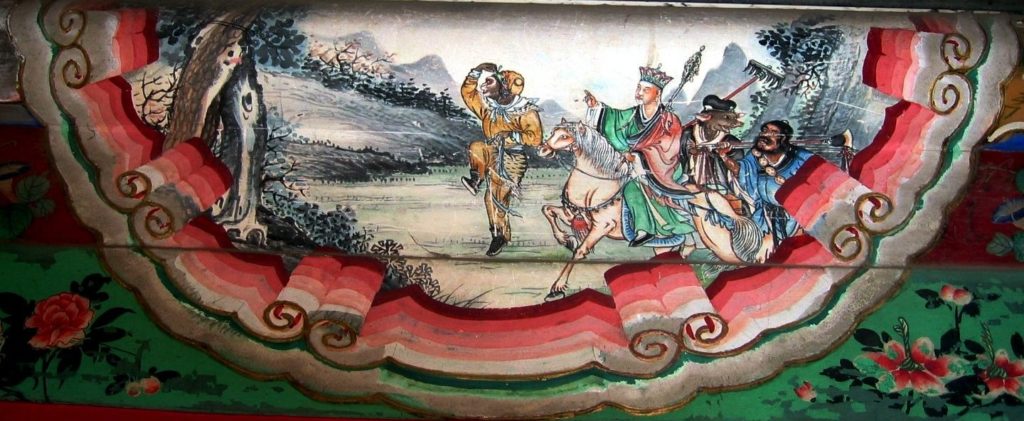
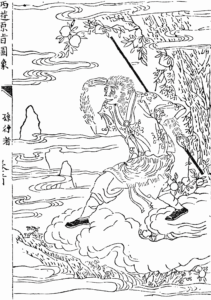
In US college students’ first course on China, the challenge for instructors is to pack the maximum amount of punch into the experience so that the course will inspire them to seek more opportunities to learn about China at and beyond the college level. One way to achieve this goal is to use a rich text with many applications to help students unpack the complexities of Chinese history, language, politics, economics, and thought. For this purpose, the sixteenth-century novel The Journey to the West, with its many incarnations, is ideal.1 It features a rousing adventure story, which can be read as historical fiction, political satire, and religious allegory. The novel has been reproduced for many types of audiences in many different media, including children’s books, puppet shows, operas, comics, TV series, and movies; each version is different enough to allow instructors to discuss them in the context of important Chinese historical events and cultural elements. Because well-told stories help us make sense of the world, instructors can use this novel as a foundational element to facilitate students’ connections with and between the various elements of the course. In this article, we show how The Journey to the West and its multiple incarnations can be used to help students unpack the complexities of China as a subject and develop a critical awareness or appreciation for a culture different from their own. We first show how the story may be introduced in a way that sets students’ minds for embracing the immense complexity of humanity and Chinese culture. Then, we show how various elements and incarnations of the story can be used to facilitate discussions about some outstanding aspects of the Ming dynasty (1368–1644), Maoist China (1949–1976), and postreform Communist China.
A Glance at The Journey to the West
Developed into its full length in the sixteenth century, the 100-chapter novel The Journey to the West (The Journey hereafter) is believed to have its historical basis in the epic pilgrimage of the monk Xuanzang (c. 596–664) to India and has been a popular subject for storytellers since the late Tang dynasty. The fictionalized pilgrimage as depicted in the novel sees Xuanzang accompanied by four nonhuman disciples: Monkey, Pigsy, Sandy, and Dragon Horse. The four disciples have been expelled by the Daoist Celestial Court (i.e., Heaven) due to misbehaviors, but will beaccepted by the Bodhisattva Guanyin (AKA the Goddess of Mercy) into Buddhism on condition that they promise to assist Xuanzang’s pilgrimage.
The mischievous Monkey character and his dedicated master Xuanzang have the central roles in the novel, and the first thirteen chapters establish the backstories of how the two became destined for the journey. The exciting part of the tale begins in chapter 14, when Xuanzang releases Monkey from a mountain and together they embark on a journey filled with the humor of Monkey’s mischievous battles against bandits and demons, interspersed with moments of Buddhist enlightenment. Starting here, students get a taste of the original novel and are introduced to the two main characters. A useful in-class exercise is to brainstorm words to describe the two characters. Through this activity, students come to understand the complexity and contrast of the characters’ personalities and why this dynamic is so important not only for the success of the story, but also metaphorically for understanding the complex nature of Chinese culture and society. For example, how have the three distinct and often-contradictory teachings—Confucianism, Daoism, and Buddhism—been able to operate relatively harmoniously in the lived religious experience of everyday Chinese? An understanding of how each individual has contradictory tendencies and how a story needs such individuals to be successful will set students’ minds for embracing the complexity of the topics to be discussed in the course, such as the various adaptations of Monkey and The Journey, and how they relate to different aspects of China.
Learning about Traditional China through The Journey
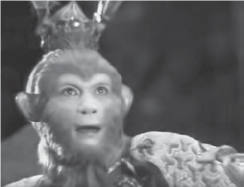
Written in the late Ming dynasty (1368–1644) and based on a true event during the Tang dynasty (618–907), The Journey offers the opportunity to introduce two of the “golden eras” in Chinese history. With almost 4,000 years of written history, there is a lot of Chinese history to potentially cover, but for a course that seeks to introduce China studies through multiple disciplinary lenses, a focus on the Ming dynasty, alongside the more recent events of the twentieth and twenty-first centuries, may suffice. The chapter on the Ming in Patricia Ebrey’s Cambridge Illustrated History of China offers a vivid depiction of Ming society.2 After reading the chapter and watching episodes 2 and 3 from the 1986 TV series of The Journey, students can quickly map the hierarchical structure of the court of the Ming government onto that of the Celestial Court in The Journey.3 Students can also connect Monkey’s eagerness to seek a position in the Celestial Court with the civil service examination in the Ming dynasty.4 From these connections, students can get a sense of China’s hierarchical social structure and its traditional emphasis on self-improvement through education. These connections serve as foundations for students to understand the historical continuities and differences when discussing the political structure and educational system of contemporary China.
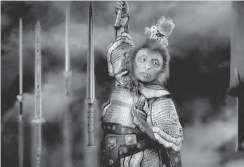
The history of the Ming dynasty is also important because it is one of the wealthiest eras in China’s history and has some interesting correlations with contemporary China, such as both being periods of international economic interactions. Employing The Journey as a fictional account of history offers a unique opportunity for the correspondences and differences between traditional and contemporary China to be highlighted and analyzed.
The syncretism of the three major teachings of traditional China, namely Confucianism, Daoism, and Buddhism, culminated when Ming General and statesman Wang Yangming’s (1472–1529) teaching of “learning of the mind” became popularized in the empire. Inspired by Chan (Japanese, Zen) Buddhist philosophy, Wang emphasized that a true understanding of the essence of morality can only be achieved through cultivating one’s own mind, which means persistent personal enactment of moral principles. The Journey depicts the lived religious experience of everyday Chinese. To help appreciate the interplay of belief systems, students can read Asian Studies Professor Joseph Adler’s Chinese Religious Traditions, accompanied by some application exercises to highlight the distinct reasoning patterns of the three major teachings. Such application exercises might include asking students to play the roles of hardcore Confucianists, Daoists, and Buddhists, who are requested to comment on such phenomena as family reverence, gender roles, death, humanity, and the vicissitudes of life.
At this point, students begin to realize that the journey actually represents the ongoing effort to end attachment to worldly things such as fame and money, which often make the mind susceptible to moral corruption. Students will also be able to identify the Confucian, Daoist, and Buddhist elements as they read other selected chapters from the novel and view other adaptations of the story, such as the movie Conquering the Demons.5Conquering the Demons is a fun movie to watch, and it presents a lively and modern interpretation of The Journey as Buddhist allegory.6
The three major teachings and their syncretism should be included in an introductory course in their own right, but they also frame the Chinese worldview and inform people’s daily practices across much of East and Southeast Asia. A solid understanding can provide a useful lens for appreciating the perspectives and practices prevalent across the region. Further, discussing the three teachings offers the opportunity to remind students of the limitation of English translations of Chinese concepts, which is an important issue involved in cross-cultural studies. For example, the Chinese word zongjiao (the clan’s teaching), a compound that first appeared in Chinese translations of Buddhist sutras referring to different schools of Buddhist thoughts, has often been equated as religion and applied to Confucianism and Daoism.7 Reflecting on what they have learned about traditional Chinese thought, students may discuss whether the three teachings, especially Confucianism, count as “religions” in the English sense.
The fact that novels like The Journey proliferated during the Ming dynasty reveals the advanced printing technology and expanded readership during the period.8 This opens up a variety of different inquiries. For example, what kinds of books got printed? How was copyright handled? Who read the books? What social changes came with the printing technology? Questions like these lead students to discussions about various aspects of social life in the Ming, such as the role of media, censorship, literacy, leisure, and women’s education and social status. These topics could and should be revisited and expanded throughout the course. The roles of technology and media also provide a useful lens for understanding contemporary China.
Learning about Maoist China through The Journey
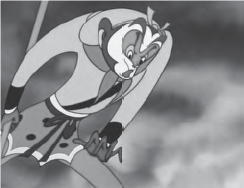
Maoist China refers to the period from the founding of the People’s Republic of China (PRC) in 1949 to the launch of the Reform and Opening Up initiative in 1978.9 The founding of the PRC was celebrated by much of the nation at the time as a great victory of the Chinese people over the oppression from imperialism, feudalism, and bureaucratic capitalism. Mao Zedong, the national leader of China from 1949 until 1976, was given the status of perfect hero or “the people’s great savior” by his cadres.10 Of course history proved that despite some positive reforms, Mao was, along with Stalin and Hitler, one the twentieth century’s most evil tyrants. It was in such historical context that the mischievous Monkey was transformed into a proletarian revolutionary hero, as depicted in the cartoon movie Havoc in Heaven (AKA The Monkey King) and several of its immediate antecedents in popular art forms and in print.11 To facilitate the discussion of the cartoon movie, background readings may include chapter 3 of Hongmei Sun’s book Transforming Monkey, which reviews the various adaptations of Monkey’s story up to the Mao years and discusses how the Monkey character was then transformed from trickster to hero.
From the 1963 cartoon movie’s depiction of the officials in the Celestial Court, students can see a prevalent Communist Chinese view of the backwardness of the alleged Chinese feudal system and the corruption of elites. By comparing the storyline of this cartoon with either the two episodes they have watched from the 1986 TV series, which also emphasize the story of Monkey’s uproar in Heaven, or chapters 3 to 7 in the novel, students will notice how the changes to the details of the cartoon make Monkey almost entirely an innocent victim of the Celestial Court. The cartoon’s ending with Monkey’s victory over the celestial troops without being subjugated by Buddha is also an interesting point for discussion. It symbolizes the victory of the proletarian revolutionaries, while ignoring religion.
Since media resources about Maoist China abound both online and in print, instructors can provide students with a list of events during this period, such as the Korean War (1950–1953), the Great Leap Forward (1958–1963), the China–USSR border dispute in the late 1960s, and the Cultural Revolution (1966–1976). Students can do research outside class and then present in class their analyses of why and how the events happened and were related. As a starting point, students should watch the documentary titled China: A Century of Revolution 1949–1976 on YouTube or read Clayton Brown’s EAA article, one of the most succinct and useful introductions to the Great Leap Forward.12 The research and discussions should get students ready for the economic reformto come, which has been the direct cause of the economic boom that lifted hundreds of millions of Chinese out of abject poverty and a series of side effects, including corruption, environmental issues, and intensifying social inequality.
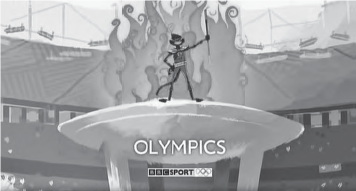
Learning about Postreform Communist China through The Journey
The launch of the Reform and Opening Up initiative by Deng Xiaoping (1904–1997) in 1978 marked a new era for China. Through a series of dramatic economic reforms and opening China’s economy to the outside world by 1980, this initiative transformed China into, until a few years ago, the world’s fastest-growing industrializing country and now the world’s second-largest economy. The famous Taiwanese cartoonist Tsai Chih-Chung’s comic version Journey to the West, first published in 1987, is an amusing way to introduce how the story was adapted to mock the popular social practices and perspectives during the early days of the economic reform.13 The inclusion of this text allows instructors to remind students why The Journey remains relevant to China and Chinese peoples, as the numerous twentieth- and twenty-first-century adaptations demonstrate. It also offers a lighthearted insight into the impact of the economic reform period. Students may also read the first two chapters of Chinese–American journalist Leslie Chang’s Factory Girls and chapters from major contemporary Chinese author Yu Hua’s book China in Ten Words for vivid depictions of Chinese society during the economic boom, and discuss where China might go next.
Themes to be explored about contemporary China can revolve around media and the concept of “soft power.” Since the early twenty-first century, soft power has been a component of China’s national development strategy and the alleged goal of the PRC’s foreign policy. Media has been employed as an important tool for manipulating soft power. For some initial knowledge of media’s role in soft power, students may read the introduction and Wanning Sun’s chapter in Screening China’s Soft Power. Sun’s chapter raises the distinction between “soft power by design” and “soft power by accident.”14 A nice media resource is the BBC’s two-minute cartoon ad for the Beijing Olympics. The cartoon features Monkey’s “journey to the East,” assuming a familiarity with the story among at least the BBC portion of the world audience.15 A discussion of why the BBC chose Monkey for the ad will introduce students to questions about China’s viability for cultural export. Later in the course, The Journey can be related more directly to the Silk Road and in turn to the Belt and Road Initiative (BRI), to be discussed in a later section.
For general knowledge of how different disciplines, such as economics and political science, have made sense of soft power and what soft power may mean for China, students can read China studies scholars Young Nam Cho and Jong Ho Jeong’s article “China’s Soft Power: Discussions, Resources, and Prospects” and social psychologist Kwang-kuo Hwang’s article “Face and Favor: The Chinese Power Game.” These readings present students with scholars’ ideas about China’s soft power potential and strategy. Cho and Jeong’s article also briefly describes the global context for China’s soft power initiative. To get a sense of China’s aggressiveness in cultural exports, students can read Media Studies Professor Aynne Kokas’s book Hollywood Made in China (particularly chapter 3), which discusses how China’s movie policy influences Hollywood, and media and democratic studies expert Shanthi Kalathil’s article “Beyond the Great Firewall,” which includes a comprehensive report of the measures China has been taking to manipulate the global information system.16 With background knowledge obtained from these readings, students will be able to generate interesting discussions as they view the media products produced in contemporary China, such as the ones to be discussed in the following sections.
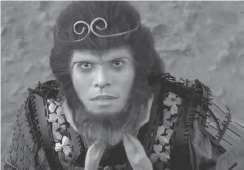
As Chinese society drastically changes, Monkey also experiences a major transformation—from a fighter to a lover who struggles to find his own identity. The transformation was marked by Stephen Chow’s movie A Chinese Odyssey (1995). Produced by a Hong Kong director two years before Hong Kong’s return to China, this movie has been interpreted as Hong Kong’s uncertainty about its fate after returning to China.17 Discussion questions invite students to consider the symbolism of Joker’s (a human bandit leader who is initially unaware that he is the reincarnation of Monkey) resistance against transforming back into the hero Monkey. Further, the ending, which leaves the viewer with a deep sense of sadness and helplessness, can spark discussions about the physical and emotional losses that the characters undergo in their spiritual journey and the hard choices they are forced to make in order for their journey to be successful.
It is also worth comparing A Chinese Odyssey with the same director’s 2013 adaptation of The Journey, Conquering the Demons. A comparison of the different endings of the movies will make students curious about events occurring during the years between the two movies, notably the return of Hong Kong to China in 1997 and the CCP’s increasing interference in Hong Kong’s administration. The comparison can also illustrate the fall of Hong Kong’s Cantopop (i.e., pop music sung in Cantonese) in the age of China.18 Reflecting this language shift, the 2013 movie adaptation, though produced in Hong Kong, is made in Mandarin instead of Cantonese and features more actors from Mainland China.
Aside from facilitating discussions of the politics and economics of language use in contemporary media, it is fair to say that A Chinese Odyssey has started a fad in more recent productions of The Journey. Not only do new movie adaptations of The Journey come out almost every year, there have also been cartoons, games, online novels, and even songs inspired by Monkey. Jin Hezai’s novel Wu Kong, first posted online in 2000, became so well-received in China that it was republished in print the following year. The novel is not available in English yet, but a movie adaptation of the same name, directed by Derek Kwok, was released in 2017, starring Eddie Peng, Shawn Yue, and Oho Ou, all of whom are popular young faces on the screen in China.
Wu Kong may be watched in its own right for its award-winning action choreography and the rebel spirit demonstrated by Monkey and his fellow fighters. The movie can be seen as an allegory of the individual fighting against the authoritarian system, which is represented by the Destiny Council in the movie.19 Every 1,000 years, the Destiny Council administrates an exam to choose new immortals who can join the Destiny Academy and become candidates for positions in the Destiny Council. This exam mirrors China’s gaokao (college entrance examination), which brings about dramatic effects on people’s lives. Discussions of the movie can be supplemented with readings about China’s education system, especially the preparation and consequences of gaokao.20 Students can explore gaokao independently and share their findings in class.
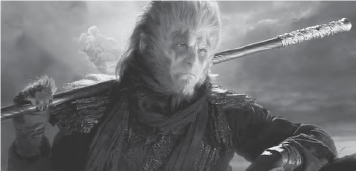
When connecting Wu Kong and gaokao, discussions can be guided to the role of family and authority/face in China. This brings back the Confucian worldview, whose fundamental metaphor is the family. In the Confucian tradition, the goal of self-cultivation is to keep the family in order, which is the prerequisite for being a leader who can put the nation in order and bring peace to the world. This understanding of the Chinese worldview becomes critical for coming to terms with some of the other elements of contemporary China’s engagement with the rest of the globe.21
The concepts of family and authority/face, by themselves may sound familiar to students, but their unique interactions in Chinese society may go beyond students’ imaginations. A discussion of these concepts in relation to business practices and China’s foreign policy can provide very important lenses for understanding contemporary Chinese society and its global ambition, epitomized by the BRI and “the Chinese dream,” both associated with current Chinese President Xi Jinping.22 The BRI has been a hot topic in the media, so after briefly introducing the “belt” and the “road” with a map, instructors may ask students to each identify a country of their interest and do research to find out what the BRI might mean for that country. Sharing their findings will provide the class with a more general picture of what the Chinese dream may entail and how China’s “journey to the West” may have extended beyond seeking the true teachings of Buddha from India and been geared toward exporting the traditional China-centered world order through the BRI.
Discussions about the China-centered world order will involve reviewing the Confucian concepts of self, family, nation, and the world (or tianxia in Chinese). Zhang Yimou’s movie Hero (2012) serves as an illustration of how a peaceful tianxia is traditionally believed to be achieved. Comparing the sacrifices and contributions of the protagonists in Hero and those of the protagonists in The Journey, students may consider the traditional Chinese ideal of “hero,” how it may adapt to the contemporary context, and how it differs from their own culture. This discussion may also lead to a discussion of China’s projected global role in the remainder of the twenty-first century and how it may be received by the rest of the world.
Conclusion
The purpose of an introductory course is to get students interested enough and academically prepared to explore the complexity and novelties of the subject. Using The Journey as the foundational element for an introductory course on China, instructors will be able to provide a tantalizing glimpse at the breadth of Chinese history, demonstrate the continuing importance of that history for understanding today’s China, and help students develop a critical awareness and appreciation for Chinese society and culture. The various adaptations of The Journey give students ready inroads for exploring the relevant content for an introductory course on China and introduce them to a variety of lenses to appreciate another culture while critically reflecting on their own.
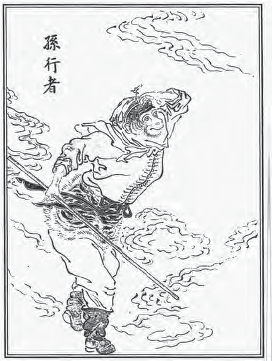
NOTES
1. Since a few selected chapters will suffice for the purpose of the course, we recommend using an English version of the full novel. This could be either W. J. F. Jenner’s Journey to the West, 4 vols., reprint ed. (Beijing: Foreign Languages Press, 1984) or Anthony C. Yu’s The Journey to the West, 4 vols., revised ed. (Chicago: University of Chicago Press, 2012).
2. Patricia B. Ebrey, Cambridge Illustrated History of China (Cambridge: Cambridge University Press, 1996), 190– 219. The titles suggested in this article are intended to be taken as suggestions found to be useful from experience rather than prescriptive requirements.
3. The 1986 TV series produced by CCTV is probably the version understood as the most authentic for many Chinese people. When the names of the characters of The Journey are mentioned, the images created by this TV series would be what many Chinese people picture in their minds.
4. The discussion about civil service examinations can be connected with contemporary China’s college entrance examination, AKA gaokao. Background readings may include Benjamin A. Elman’s article “Civil Service Examinations” in Education in China: Educational History, Models, and Initiatives, ed. Qiang Zha, Ruth Hayhoe, and Heidi Ross (Great Barrington, MA: Berkshire Publishing, 2013); chapter 6 of Yong Zhao’s book Who’s Afraid of the Big Bad Dragon: Why China Has the Best (and Worst) Education System in the World (San Francisco: Jossey–Bass, 2014); and Hoi K. Suen and Lan Yu’s article “Chronic Consequences of High-Stakes Testing? Lessons from the Chinese Civil Service Exam” in Comparative Education Review 50, no. 1 (2006): 46–65.
5. Journey to the West: Conquering the Demons, directed by Stephen Chow and Derek Kwok (Hong Kong: Bingo Movie Development, 2013).
6. The movie Conquering the Demons may be seen as essentially about the spiritual transformation of Xuanzang, who was eventually able to get rid of his worldly attachments by facing and conquering them one by one. The three demons, whom Xuanzang encountered and conquered with the help of the demon hunter Ms. Duan (whose family name shares the same sound as the Chinese word for “to cut off”), may each symbolize a stubborn worldly attachment. That the conquered demons became Xuanzang’s companions on his journey to the west may be a symbol of his spiritual maturity as a Buddhist pilgrim.
7. Shenglai Zhou, “Origin and Evolution of zongjiao, a Word in Chinese,” Journal of Shanghai Normal University (Philosophy & Social Science Edition) 40, no. 5 (2011): 114–119. According to Zhou, the use of zongjiao as the Mandarin counterpart for “religion” is actually a nineteenth-century borrowing from the Japanese, who expanded the meaning of the term to match the Western concept.
8. Two useful readings on these topics are Anne E. McLaren’s chapter “Constructing New Reading Publics in Late Ming China,” in Cynthia J. Brokaw and Chow Kai-wing, eds. Printing and Book Culture in Late Imperial China (Berkeley: University of California Press, 2005) and Raymond Chang’s article “The Renaissance of Book Arts in the Ming Period,” The Journal of Library History (1974–1987) 16, no. 3 (1981): 501–508. 9.We readily acknowledge that events between the Ming dynasty and the Communist China period, such as two opium wars and two world wars, left significant traces on Chinese and world history. However, the Communist China period is more relevant to the students, most of whom (if they are interested in Asia at all) are interested in career opportunities outside the academic field. Therefore, it is appropriate for an introductory course to put more emphasis on Communist China when talking about modern China.
10. This term has been extracted from the Chinese song titled “The East Is Red,” whose lyrics idealize Mao as a perfect hero. This song was the de facto national anthem of the People’s Republic of China during the Cultural Revolution in the 1960s.
11. Hongmei Sun, Transforming Monkey (Seattle: University of Washington Press, 2018), 83.
12. Clayton Brown, “China’s Great Leap Forward,” Education About Asia 17, no. 3 (2012): 29–34.
13. For instance, the social phenomena mocked in the chapter “A Duel with Buddha” include pirating, pursuit for instant profits, the enthusiasm for studying abroad in the USA, the serious littering at tourist sites, the attraction of the movie industry, and the popularity of instant noodles and other Western goods such as perfume, etc. Tsai Chi-Chung’s Journey to the West comic series is now available in English versions and bilingual versions. For the purpose of the course, selected chapters from the English translations published by Asiapac Books Pte. Ltd. in 1993 would suffice. For interested readers, the entire set of thirty-eight volumes were made available in 2006 by Modern Publishing House in China.
14. Wanning Sun, “Soft Power by Accident or by Design,” in Screening China’s Soft Power, eds. Paola Voci and Luo Hui (London: Routledge, 2017), 196.
15. Ollie Williams, “Monkey’s Journey Begins,” BBC Sport, May 28, 2008, https://tinyurl.com/54v79w.
16. Articles and books mentioned in this paragraph: Young Nam Cho and Jong Ho Jeong, “China’s Soft Power: Discussions, Resources, and Prospects,” Asian Survey 48, no. 3 (2008): 453–472; Kwang-kuo Hwang’s “Face and Favor: The Chinese Power Game,” American Journal of Sociology 92, no. 4 (1987): 944 –974; Aynne Kokas, Hollywood Made in China (Berkeley: University of California Press, 2017); and Shanthi Kalathil, “Beyond the Great Firewall,” Center for International Media Assistance, accessed April 4, 2019, http://tinyurl.com/y2xrsmke.
17. A Chinese Odyssey, directed by Stephen Chow (Beijing: Xi’an Film Studio, 1995). Also see Hongmei Sun, Transforming Monkey, 95.
18. Yiu-Wai Chu, Hong Kong Cantopop (Hong Kong: Hong Kong University Press, 2017), 184–195.
19. Wu Kong, directed by Derek Wong (Beijing: New Classics Media, 2017). Based upon the 2000 online novel Wu Kong’s Biography by Jin Hezai. See also Derek Elley, “Review: Wu Kong (2017),” Sino-Cinema, 2017, accessed July 20, 2018, https://tinyurl.com/yx9ckaeg.
20. See note 4 above for suggested readings on gaokao.
21. Some background readings about the China-centered world order may include David Bell’s chapter “Realizing Tianxia: Traditional Values and China’s Foreign Policy,” in Chinese Visions of World Order, ed. Ban Wang (Durham: Duke University Press, 2017) and Suisheng Zhao’s article “Rethinking the Chinese World Order: The Imperial Cycle and the Rise of China,” Journal of Contemporary China 24, no. 96 (2015): 961–982.
22. The Chinese Dream, popularized in 2013, refers to the personal and national ideals for individuals and the government in China, including Chinese prosperity, collective effort, socialism, and national glory.

